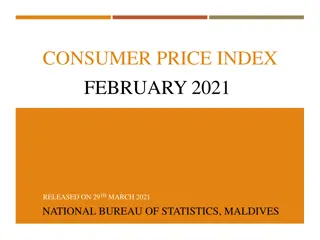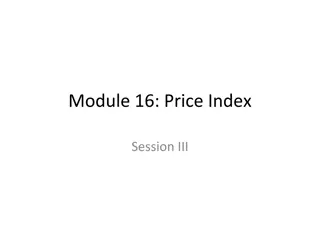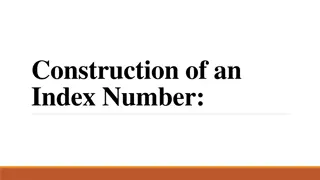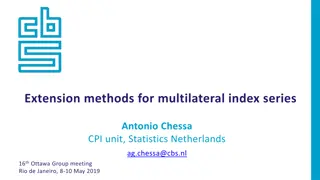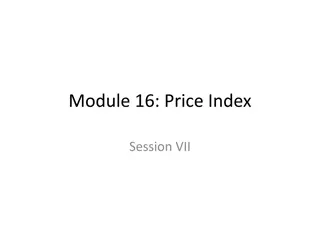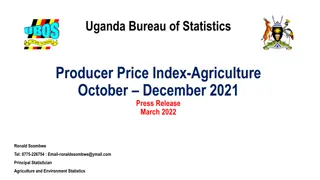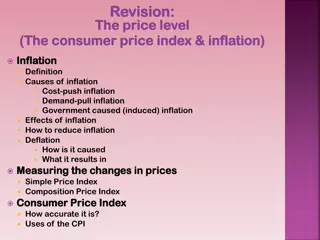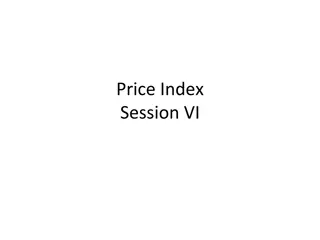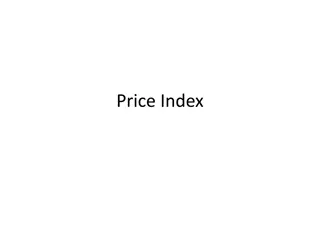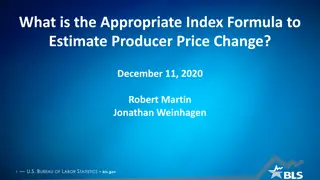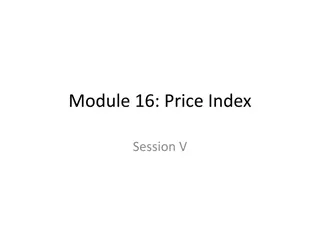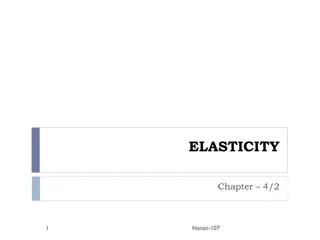Module 16: Price Index
Calculation and adjustments in price indices involve aligning weight and reference periods, handling missing price data, incorporating seasonal products, and adjusting for quality changes. Different methods are used to address missing price observations, ensuring accuracy in index calculations.
Download Presentation

Please find below an Image/Link to download the presentation.
The content on the website is provided AS IS for your information and personal use only. It may not be sold, licensed, or shared on other websites without obtaining consent from the author.If you encounter any issues during the download, it is possible that the publisher has removed the file from their server.
You are allowed to download the files provided on this website for personal or commercial use, subject to the condition that they are used lawfully. All files are the property of their respective owners.
The content on the website is provided AS IS for your information and personal use only. It may not be sold, licensed, or shared on other websites without obtaining consent from the author.
E N D
Presentation Transcript
Module 16: Price Index Session VIII
Contents Session VIII Treatment of Missing Prices and other adjustments Calculation of price relatives and elementary indices Index aggregation Alignment of expenditure and price reference base Chaining re-weighted indices Adjustments for Seasonal products Adjustments for Quality changes Data editing 2
Treatment of Missing Prices and other adjustments
Treatment of missing price data Calculating Price Index Recall that compilation of a price index is done in three stages. Its calculation also requires aligning weight and price reference periods with the index reference period and chaining re-weighted indices. In addition, calculation of an index also includes adjustments made for missing price observations seasonal items and quality change.
Treatment of missing price data Calculating Elementary Price Index Issues involved: Weights within elementary index: Usually, calculated as averages with no explicit weights, but sometimes requires implicit weights introduced by the sampling selection procedure. Missing price observations Seasonal items Quality adjustment
Treatment of missing price data Missing Data Temporarily missing prices of non-seasonal products: Methods most frequently used are as follows: taking no action; carrying forward the last available price; imputing prices.
Treatment of missing price data Missing Data no action The observation gets omitted from the calculations till the missing price returns. The index suffers from a systematic upward or downward bias, depending upon whether the price movement of the missing product is flatter or sharper than the rest of the items in the elementary aggregate. Thus, a better method is to use imputed prices for all the periods when observations cannot be made.
Treatment of missing price data Example 24: No Action taken for missing price data in elementary aggregation prices in quotation number Current period 4 Base period 1 2 3 5 6 7 Jevon's 108.0 114.3 124.4 Calculate these values in your workbook 142.2 154.6 171.4 177.5 Carli's 108.1 114.4 124.8 142.8 155.1 174.6 181.4 Dutot's 108.2 114.4 124.6 142.9 155.0 174.1 181.1 1 15.3 16.7 17.9 19.8 24.7 25.9 29.5 34.8 2 15.5 17.9 18.0 17.4 21.0 21.6 20.2 19.8 3 14.8 14.7 16.4 19.7 19.4 23.2 29.7 28.4 4 14.5 15.7 16.5 n.a. n.a. n.a. n.a. 25.9
Treatment of missing price data Missing Data Carrying forward A common treatment is carrying forward the last available price to the months when prices are not available. Evidently, this leads to biased indices for the months the price remains missing. As the price relatives in question will remain flat when prices are not available, the bias will be downwards in rising-price situations and the bias will be upwards in falling-price situations. There is also likely to be a large step-change in the index when the price becomes available again.
Treatment of missing price data Example 25: Carrying forward the last available price prices in quotation number Current period 4 Base period 1 2 3 5 6 7 Jevon's 108.0 114.3 177.5 121.6 Calculate these values in your workbook 134.4 143.1 154.6 Carli's 108.1 114.4 181.4 122.0 135.5 144.7 159.3 Dutot's 108.2 114.4 181.1 122.0 135.8 145.0 159.5 1 16.7 17.9 17.9 19.8 24.7 25.9 29.5 34.8 2 17.9 18.0 18.0 17.4 21.0 21.6 20.2 19.8 3 14.7 16.4 16.4 19.7 19.4 23.2 29.7 28.4 4 15.7 16.5 16.5 16.5 16.5 16.5 16.5 25.9
Treatment of missing price data Missing Data Imputation (1) By far the best solution for missing prices of non-seasonal products is imputing prices. Two ways of Imputation: implicit imputation of elementary price index or explicit imputation of the missing price. In implicit imputation the missing price relative and its weight are simply dropped or omitted from all calculations, as in Example 24. Thus, the elementary index is based only on those price relatives that are available. The missing price relative implicitly assumes the same value as the elementary index.
Treatment of missing price data Missing Data Imputation (2) In explicit imputation, the missing price for the missing item is explicitly estimated and the elementary index is calculated using the imputed value. It is recommended that imputations should always be made explicitly. Imputation whether implicit or explicit makes use of the best available information to provide an unbiased estimate of price movement. Imputation can be done using prices or elementary indices or higher level indices.
Treatment of missing price data Missing Data Index aggregation The elementary aggregates obtained after making the required adjustments are combined using some kind of index number formula and weights. All the adjustments for missing prices, seasonal goods & services and quality changes are usually made at the stage of calculating price relatives and elementary aggregation. For aggregation at higher levels, only the weights may have to be adjusted, as a result of changes in weights made for elementary indices.
Treatment of missing price data Alignment of weight and pricereference base While the index reference period is set to coincide with the price reference period, the weight reference period is usually different. The price reference period and index reference period are normally the same and is commonly either a whole year or a single month. But, the reference period for the weights is often different from that for the prices. The linking is made by price updating of weights. [Please refer to Sessions II & V]
Treatment of missing price data Chaining re-weighted indices A chain index consists of a series of successive indices, each linked (spliced) to its predecessor. Example 26 in the next slide illustrates the method of chain- linking. Linked indices can be produced at any level, i.e. item, product, group, total CPI. Recommendation: aggregation should always be done before chain-linking, i.e. linking should always be the last stage in the process.
Treatment of missing price data Example 26: Annually Chained price index For a price index with index reference period 2005, annually chained weights are used. Col. (3) shows the initial weights, which are used for deriving the all-item price index for 2006. Cols(4) & (6) show the group-level price indices of respectively 2006 and May 2007. The individual item groups weights for 2007 are obtained as follows: ???. 3 ???. 4 ???. 4 , ??? ????? ???. 5 = 2006 May 2007 Base index (2005) (initial) weights (3) Index Item groups weights index (average) (4) (1) (2) (5) (6) All Items Food Beverage &Tobacco Clothing & Footwear Housing Household operation Transport Miscellaneous 100.0 100.0 100.0 100.0 100.0 100.0 100.0 100.0 100.0 53.2 6.5 4.1 18.0 6.2 6.6 5.4 113.1 105.6 123.7 108.3 126.7 116.5 133.7 103.2 100.0 49.7 7.1 3.9 20.2 6.4 7.8 4.9 120.2 110.2 122.4 122.7 136.9 126.9 130.1 122.8 Calculate these values in your workbook
Dealing with Seasonal Product Dealing with Seasonal Product In practice, the adjustments for seasonality are made in the form of: Excludingseasonal products: not an unacceptable solution these may account for a significant proportion. Month-to-month movement: measuring price movements of the index of seasonal products to changes between the same month in successive years. Imputation: Adjustments by imputation consists of imputing prices of seasonal products for the months when their prices are not available. Variable Weights: This kind of adjustments requires using a system of variable weights. The seasonal items are assigned different weights in different months.
Dealing with Seasonal Product Example 27: Seasonal Adjustment Variable Weight (1) A seasonal product (say mango) is known to available in specific months of the year March to August. In the fruit group, mango has a weight of 33%. weight (%) in group D.2 elementary index in current period Elementary aggregate Jan. Feb. Mar. Apr. May June July Aug Sept. D.2 100 127.9 130.8 124.8 133.6 137.8 140.8 D.2.1 22 110.0 114.3 118.2 128.5 129.0 134.6 137.5 140.2 142.3 D.2.2 33 n.a. n.a. 148.2 145.2 120.9 139.4 146.4 150.0 n.a. D.2.3 25 111.9 114.5 117.1 123.8 125.1 128.9 132.2 135.3 138.6 D.2.4 20 110.8 113.9 118.8 118.3 126.3 129.1 130.7 133.2 135.6
Dealing with Seasonal Product Example 27: Seasonal Adjustment Variable Weight (2) weight (%) in group D.2 elementary index in current period Elementary aggregate initial adjusted Jan. Feb. Mar. Apr. May June July Aug Sept. 100 Calculate these values in your 138.9 D.2 100 110.9 114.3 127.9 130.8 124.8 133.6 137.8 140.8 D.2.1 22 32.8 110.0 114.3 118.2 128.5 129.0 134.6 137.5 140.2 142.3 workbook D.2.2 33 0 n.a. n.a. 148.2 145.2 120.9 139.4 146.4 150.0 n.a. D.2.3 25 37.3 111.9 114.5 117.1 123.8 125.1 128.9 132.2 135.3 138.6 D.2.4 20 29.9 110.8 113.9 118.8 118.3 126.3 129.1 130.7 133.2 135.6
Calculation in Practice Quality Adjustment Quality adjustment When an old product is replaced by a new product of different quality, it is essential to make a quality adjustment. A quality adjustment of the replacement item s price is to multiply the new product s price by a coefficient ( ). (1 / ) represents the part of the price change owing to quality difference between the replaced and replacement items. In practice, an estimate of the coefficient is obtained from data available.
Calculation in Practice Quality Adjustment Measuring Change in Quality The two situations discussed below are most common: The old and new products have been available simultaneously for some time in reasonable quantities. If the prices of both have been fairly stable, it is assumed that the price difference between the products is attributable to the difference in quality of the products. The two products are not available at the same time or if their prices have been unstable. The ratio of production costs of the two is used along with judgement based on other information. In situation (i), the new series is simply spliced to the old one. The procedure is illustrated in Example 28 below.
Calculation in Practice Quality Adjustment Example 28: Quality Adjustment Assuming price difference is attributable to quality difference The old product is available in the market till June. The new product has been available since January. We calculate the relative prices of the two products and use the average relative price as the coefficient for price adjustment by dividing the prices of the new product in July, Aug. & Sept. by the coefficient. prices in current period Product Jan. Feb. Mar. Apr. May June July Aug Sept. old 14.5 14.7 15.5 15.5 15.7 16.0 -- -- -- new 18.0 18.1 19.8 19.3 19.9 20.5 20.4 21.1 22.0 relative price 1.24 1.23 1.28 1.25 1.27 1.28 Calculate these values in your workbook adjusted price 14.5 14.7 15.5 15.5 15.7 16.0 16.2 16.8 17.5
Calculation in Practice Quality Adjustment Quality adjustment without measure of quality change One of the following alternatives is adopted: Any quality differences is ignored, i.e., if there is any price difference it is treated as a genuine price movement. In this case the price of the new variety can be compared directly with that of the old variety, and 100% of the price difference is reflected in the index. Assuming that the entire price difference is due to quality difference. There are several ways of doing this: First, by overlap imputation, discussed earlier. Underlying assumption is that the price difference is due to quality differences. If there is no overlap period, imputed price movement is created by class mean or overall mean imputation.
Calculation in Practice Data Editing Validation Validation or data editing is an integral part of survey data processing. Different types of checks or edit rules or simply edits are used for this purpose. Most commonly used edit for price data is range checks on change in price. Range checks are set for each item and are applied on all the quotations on it. These are used for Price level Change in price with respect to previous period, or previous quarter or corresponding period of the previous year etc.
Calculation in Practice Data Editing Identification of error Identification of errors is carried out by: non-statistical checking of input data statistical checking of input data and output checking.
Calculation in Practice Data Editing & Imputation Non-statistical checking of input data Non-statistical checking is undertaken mainly by manually checking of the survey data. The manual checking is mainly undertaken to examine completeness of the data received this is called checking the coverage, identifying some kind of errors relating to ID particulars and detecting a selected kind of errors in price quotations. The checking of the first two kinds is essential at the manual checking stage. Detecting errors in price data by manual examination, however, is extremely time-consuming and does not ensure identification of all errors.
Calculation in Practice Data Editing & Imputation Statistical checking The statistical techniques used for this purpose are based mainly on filtering of the following three broad kinds: tests based on the median and quartiles of price changes based on the log normal distribution of price changes. checking by impact, or data output checking. The first two are beyond the scope of this module. The third method is described in the next slide.
Calculation in Practice Data Editing & Imputation Output checking Filtering by impact, or output editing, is based on calculating the impact that an individual price change has on an index to which it contributes. The index can be an elementary aggregate index, the total index, or some other aggregate index. A minimum value for this impact the product of percentage change and effective weight is set, so that all price changes that cause an impact greater than this change can be flagged for review.
Calculation in Practice Data Editing & Imputation Dealing with errors Treatment of outliers: We are here concerned with the extreme values that have been verified as being correct. The outlier adjustment essentially consists of imputation based on comparable set of prices. Treatment of missing price observations: Treatments of temporarily missing price data and permanently missing price data have already been discussed earlier in this session.
End of Module Price index Thanks


